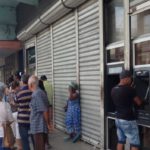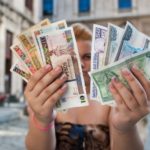Shortages, Now it’s Ice Cream’s Turn.
As in the old joke of socialist hell the products in Cuba disappear in turn. When there are potatoes, there is no oil to fry them in, when there is spaghetti, there’s no tomato sauce, and just when they release enough flour to make a cake, there are no eggs to beat into meringue. At the beginning of the year there were no national brands of beer in any market, and now it’s ice cream’s time to go silent, especially that distributed by the firm Swiss Nestle.
According to sources from the Ministry of Food Industry, the assembly of the new equipment of the Swiss Firm Nestle will be necessary to wait until the 25th when technicians of the supplier company will arrive in the country to approve the work. From that moment on, steam will begin to arrive at the Nestlé factory.
It’s been a long time since some of the specialties distributed by the Swiss firm have disappeared from the market, such as Mega ice cream bars, cones and platicas, many of which, despite their absence, remain on the advertising posters. Parents have to challenge their imagination to explain to the kids why they only sell the little 450-milliliter plastic pots at prices that vary between 1.35 and 1.75 CUC.
Although not considered a luxury product, Nestle ice cream is not a popularly consumed commodity, as the purchase of one pot a week would consume 40% of the average monthly salary of 350 Cuban pesos. If all goes as expected, the officials in charge of the new investments will return the flavors chocolate, strawberry and vanilla, the most coveted, to the shelves in June. The question is, what will there be a shortage then.
Australia Accepts Cuban Emigrants
The last rafters who remained at the Guantanamo Naval Base waiting to be welcomed by a third country already have a destination on the other side of the globe. Australia decided to accept the 17 Cubans under refugee status, migrants and their families said.
“Next month they travel to Australia, they are finishing the papers, the wait was worth it,” they add.
In recent years distant Australia has become a destination for those who want to settle outside the island. In the state of Victoria, the second smallest in the country, there are about 150 Cubans, according to figures provided by the Ministry of Foreign Affairs, While data published by the United Nations in 897 indicate the total number of Cubans living throughout the country.
Where do Cubans keep their money?
Finding a coin canister that her father hid in the courtyard occupied part of the youth of Eneida, a retiree who today says she is financially “escaped and without a weight in the bank.” Of his family he inherited an old house in the center of the city of Santa Clara and the conviction of not putting his savings in the hands of the State.
Each month, the pensioner goes to the nearest ATM, takes out the amount of her retirement, equivalent to about 12 dollars, and stores it inside an old coffee can. “I prefer to have it close because in most stores there are problems to pay with a magnetic card.”
The Santa Clara also fears the authorities because, in her opinion, “you never know when they will confiscate something.”
The younger ones see it differently. It is not the mistrust that guides them to not having bank accounts, but the economic precariousness of the day to day. “Save money?”, A young student at the University of Pedagogical Sciences is questioned with disbelief, who works out of school hours as a messenger to distribute the weekly package.
“That having savings is a thing of the rich,” he says. Most of their friends live on what the parents give them or earn their living, “but to save is not enough,” he says.
Cuba loses agricultural harvest in distribution
Agriculture in Cuba is among the lowest performing in Latin America according to an evaluation published by the non-governmental organization Mundubat, based in the Basque Country (Spain) working with Cuban officials ANAP, Cuban Association of Agricultural Technicians and Cuban Association Of Animal Production. In the island, losses during harvest and after collection represent 30% of total production, while in the distribution stages they reach 27%.
The text includes an evaluation carried out jointly between the NGO and Veterinarios sin Fronteras (VSF). Both organizations are part of a cooperation agreement with Cuba, started in 2014 and funded mainly by the Spanish Agency for International Cooperation for Development.
The island suffers from “degraded soils with low levels of organic matter, high incidence of pests and diseases,” along with “high salinity, soil compaction and overgrazing”. Weed invasion and manure contamination aggravate the landscape.
“The scarce investment in technology” limits “production even more.” Mundubat catalogs as “low quality” the final products offered for consumption. A situation that points to “poor processing in the early stages of harvest”, “deteriorated storage systems” and “lack of experience in adding value to primary products.”
The different production units “do not meet the internal demands” and “the low and unstable availability of food throughout the year” and fluctuating prices “characterize the food supply”.
La escasez, ahora es la vuelta del helado.
Como en la vieja broma del infierno socialista, los productos en Cuba desaparecen a su vez. Cuando hay patatas, no hay aceite para freírlas, cuando hay espaguetis, no hay salsa de tomate, y justo cuando liberan suficiente harina para hacer un pastel, no hay huevos para batir en merengue. A principios de año no había marcas nacionales de cerveza en ningún mercado, y ahora es el tiempo de los helados para callar, especialmente el que distribuye la firma suiza Nestlé.
Según fuentes del Ministerio de Industria Alimentaria, será necesario el montaje del nuevo equipo de la firma suiza Nestlé para esperar hasta el día 25 cuando los técnicos de la empresa suministradora lleguen al país para aprobar la obra. A partir de ese momento, el vapor comenzará a llegar a la fábrica de Nestlé.
Ha pasado mucho tiempo desde que algunas de las especialidades distribuidas por la firma suiza han desaparecido del mercado, como Mega helados, conos y platicas, muchos de los cuales, a pesar de su ausencia, permanecen en los carteles publicitarios. Los padres tienen que desafiar su imaginación para explicar a los niños por qué sólo venden las pequeñas ollas de plástico de 450 mililitros a precios que varían entre 1,35 y 1,75 CUC.
Aunque no se considera un producto de lujo, el helado de Nestlé no es un producto popularmente consumido, ya que la compra de una olla a la semana consumiría el 40% del salario promedio mensual de 350 pesos cubanos. Si todo va como se esperaba, los responsables a cargo de las nuevas inversiones devolverán los sabores chocolate, fresa y vainilla, los más codiciados, a los estantes en junio. La pregunta es, ¿qué habrá una escasez de entonces.
Australia Acepta Emigrados Cubanos.
Los últimos balseros que permanecían en la Base Naval de Guantánamo a la espera de ser acogidos por un tercer país ya tienen destino al otro lado del globo. Australia decidió aceptar a los 17 cubanos bajo la condición de refugiados, según han dicho los emigrantes y sus familiares.
“El próximo mes viajan a Australia, ya están terminando los papeles, la espera valió la pena”, agregan.
En los últimos años la distante Australia se ha convertido en un destino para quienes quieren radicarse fuera de la Isla. En el estado de Victoria, el segundo más pequeño del país, residen unos 150 cubanos, según cifras brindadas por el Ministerio de Relaciones Exteriores, mientras que datos publicados por las Naciones Unidas cifran en 897 el total de cubanos que viven en todo el país.
Donde guardan los cubanos su dinero?
Encontrar una botija con monedas que su padre escondió en el patio ocupó parte de la juventud de Eneida, una jubilada que hoy dice estar financieramente “escachada y sin un peso en el banco”. De su familia heredó una vieja casona en el centro de la ciudad de Santa Clara y la convicción de no poner sus ahorros en manos del Estado.
Cada mes, la pensionada va hasta el cajero automático más cercano, saca el monto de su jubilación, equivalente a unos 12 dólares, y lo guarda dentro de una vieja lata de café. “Prefiero tenerlo cerquita porque en la mayoría de las tiendas hay problemas para pagar con tarjeta magnética”.
La santaclareña también recela de las autoridades ya que, en su opinión, “nunca se sabe cuándo van a confiscar algo”.
Los más jóvenes lo ven de otra manera. No es la desconfianza lo que los guía a no tener cuentas bancarias, sino la precariedad económica del día a día. “¿Guardar dinero?”, se cuestiona con incredulidad un joven estudiante de la Universidad de Ciencias Pedagógicas que fuera del horario escolar trabaja como mensajero para distribuir el paquete semanal.
“Eso de tener ahorros es cosa de ricos”, opina. La mayoría de sus amigos viven de lo que les dan los padres o se ganan el sustento diario, “pero para ahorrar no alcanza”, asegura.
Cuba pierde cosecha agrícola en su distribución.
La agricultura en Cuba está entre las de más bajo rendimiento de América Latina según una evaluación publicada por la organización no gubernamental Mundubat, radicada en el País Vasco (España) que trabaja con las oficialistas de Cuba ANAP, Asociación Cubana de Técnicos Agrícolas y Asociación Cubana de Producción Animal. En la Isla, las pérdidas durante la cosecha y con posterioridad a su recogida representan el 30% de la producción total, mientras que en las fases de distribución alcanzan el 27%.
El texto recoge una evaluación realizada de manera conjunta entre la ONG y Veterinarios sin Fronteras (VSF). Ambas organizaciones forman parte de un convenio de cooperación con Cuba, iniciado en 2014 y financiado mayoritariamente por la Agencia Española de Cooperación Internacional para el Desarrollo.
La Isla padece de “suelos degradados y con bajos índices de materia orgánica, elevada incidencia de plagas y enfermedades”, junto a una “alta salinidad, compactación del suelo y sobrepastoreo”. La invasión de maleza y la contaminación por purines agravan el panorama.
“La escasa inversión en tecnología” limita “todavía más la producción”. Mundubat cataloga como de “baja calidad” los productos finales ofertados al consumo. Una situación que apunta a un “deficiente procesamiento en las fases iniciales de cosecha”, “deteriorados sistemas de almacenamiento” y “falta de experiencias en la incorporación de valor agregado a los productos primarios”.
Las distintas unidades productivas “no satisfacen las demandas interna” y “la baja e inestable disponibilidad de alimentos a lo largo de todo el año” y los precios fluctuantes “caracterizan el abastecimiento de alimentos”.
Agencies/14ymedio, La Habana/Internet Photos/Arnoldo Varona/TheCubanHistory.com
THE CUBAN HISTORY, HOLLYWOOD.



 > BRIEF, INSIDE CUBA: Emigrants to Australia, Ice Cream Shortages.. + BREVES, CUBA POR DENTRO: Emigrados a Australia, Escasez de Helados..
> BRIEF, INSIDE CUBA: Emigrants to Australia, Ice Cream Shortages.. + BREVES, CUBA POR DENTRO: Emigrados a Australia, Escasez de Helados..








